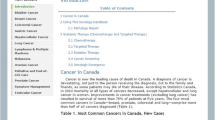Abstract
There is an urgent need for efficient cancer education programmes to promote safe practice in a comprehensive cancer centre. Educational practice has developed historically in an unplanned and inefficient way. Developments in educational theory and information technology provide an opportunity to develop systems with better educational methodology, better efficiency and potential for better impact on safety outcomes. We have developed such a programme at St. George Comprehensive Cancer Centre in Sydney, Australia, and describe here our experience in the first 2 years of implementing such a programme. In this article, we describe the programme, the obstacles and solutions we encountered and our reflections on the journey so far.
Similar content being viewed by others
References
Vandenberg T et al (2009) A framework for the organization and delivery of systemic treatment. Curr Oncol 16(1):4–15
Trufelli DC et al (2008) Burnout in cancer professionals: a systematic review and meta-analysis. Eur J Cancer Care (Engl) 17(6):524–531
McGrath BP et al (2006) Lack of integration of medical education in Australia: the need for change. Med J Aust 184(7):346–348
Kohn LT, Corrigan J, Donaldson MS (2000) To err is human: building a safer health system. National Academy Press, Washington, DC, p 287, xxi
Runciman WB (2010) Patient safety: time for a transformational change in medical education. Med J Aust 193(1):3–4
Australian Council for, S.Q.i.H., Care (2005) National patient safety education: framework, ed. S. Australian Council for and C. Quality in Health. Australian Council for Safety and Quality in Health Care, Canberra
Van Der Weyden MB (2007) Challenges and change in medical training: the Australian Curriculum Framework for Junior Doctors. Med J Aust 186(7):332–333
Dahlenburg GW (2006) Medical education in Australia: changes are needed. Med J Aust 184(7):319–320
Kaufman DM (2003) Applying educational theory in practice. BMJ 326(7382):213–216
Spencer JA, Jordan RK (1999) Learner centred approaches in medical education. BMJ 318(7193):1280–1283
Nahrwold DL (2005) Continuing medical education reform for competency-based education and assessment. J Contin Educ Health Prof 25(3):168–173
Voelker R (2005) AMA, AAMC say reform needed across continuum of US medical education. JAMA 294(4):416–417
Atreja A et al (2008) Satisfaction with web-based training in an integrated healthcare delivery network: do age, education, computer skills and attitudes matter? BMC Med Educ 8:48
Boulos M, Maramba I, Wheeler S (2006) Wikis, blogs and podcasts: a new generation of Web-based tools for virtual collaborative clinical practice and education. BMC Med Educ 6(1):41
Biggs JB, CS-K Tang, JBTfqlau Biggs (2007) Teaching according to how students learn. Chapter 1 In: Teaching for quality learning at university: John Biggs, Catherine Tang. McGraw Hill/Society for Research into Higher Education & Open University Press, Maidenhead. xviii, 335 p
Hord S (1997) Professional learning communities: communities of continuous inquiry and improvement. Southwest Educational Development Laboratory, Austin
Reason P, Bradbury H (2008) The SAGE handbook of action research: participative inquiry and practice, 2nd edn. Sage, Los Angeles, p 720, xxxii
Prensky M (2010) Teaching digital natives: partnering for real learning. Corwin Press, Thousand Oaks, xx, 203 p
Acknowledgements
We would like to acknowledge the support of the Cancer Institute NSW who funded the latter part of this project and the support of all the staff who gave their time so enthusiastically.
Conflict of Interest
The authors declare that they have no conflict of interest.
Author information
Authors and Affiliations
Corresponding author
Rights and permissions
About this article
Cite this article
Links, M., Sargeant, C., Waters, A. et al. Implementing a Multi-professional Web-based Learning Environment for a Comprehensive Cancer Centre: Obstacles, Solutions and Reflections. J Canc Educ 27, 37–41 (2012). https://doi.org/10.1007/s13187-011-0261-8
Published:
Issue Date:
DOI: https://doi.org/10.1007/s13187-011-0261-8




